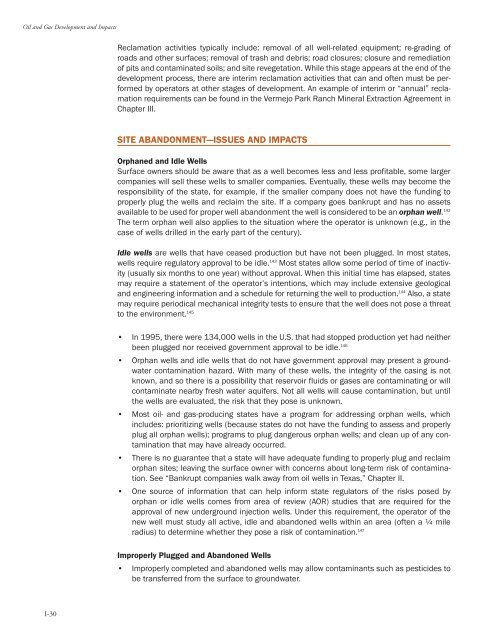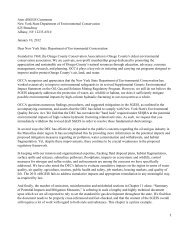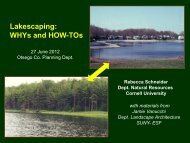Oil and Gas at Your Door? (2005 Edition) - Earthworks
Oil and Gas at Your Door? (2005 Edition) - Earthworks
Oil and Gas at Your Door? (2005 Edition) - Earthworks
You also want an ePaper? Increase the reach of your titles
YUMPU automatically turns print PDFs into web optimized ePapers that Google loves.
<strong>Oil</strong> <strong>and</strong> <strong>Gas</strong> Development <strong>and</strong> Impacts<br />
Reclam<strong>at</strong>ion activities typically include: removal of all well-rel<strong>at</strong>ed equipment; re-grading of<br />
roads <strong>and</strong> other surfaces; removal of trash <strong>and</strong> debris; road closures; closure <strong>and</strong> remedi<strong>at</strong>ion<br />
of pits <strong>and</strong> contamin<strong>at</strong>ed soils; <strong>and</strong> site reveget<strong>at</strong>ion. While this stage appears <strong>at</strong> the end of the<br />
development process, there are interim reclam<strong>at</strong>ion activities th<strong>at</strong> can <strong>and</strong> often must be performed<br />
by oper<strong>at</strong>ors <strong>at</strong> other stages of development. An example of interim or “annual” reclam<strong>at</strong>ion<br />
requirements can be found in the Vermejo Park Ranch Mineral Extraction Agreement in<br />
Chapter III.<br />
SITE ABANDONMENT—ISSUES AND IMPACTS<br />
Orphaned <strong>and</strong> Idle Wells<br />
Surface owners should be aware th<strong>at</strong> as a well becomes less <strong>and</strong> less profitable, some larger<br />
companies will sell these wells to smaller companies. Eventually, these wells may become the<br />
responsibility of the st<strong>at</strong>e, for example, if the smaller company does not have the funding to<br />
properly plug the wells <strong>and</strong> reclaim the site. If a company goes bankrupt <strong>and</strong> has no assets<br />
available to be used for proper well ab<strong>and</strong>onment the well is considered to be an orphan well. 142<br />
The term orphan well also applies to the situ<strong>at</strong>ion where the oper<strong>at</strong>or is unknown (e.g., in the<br />
case of wells drilled in the early part of the century).<br />
Idle wells are wells th<strong>at</strong> have ceased production but have not been plugged. In most st<strong>at</strong>es,<br />
wells require regul<strong>at</strong>ory approval to be idle. 143 Most st<strong>at</strong>es allow some period of time of inactivity<br />
(usually six months to one year) without approval. When this initial time has elapsed, st<strong>at</strong>es<br />
may require a st<strong>at</strong>ement of the oper<strong>at</strong>or’s intentions, which may include extensive geological<br />
<strong>and</strong> engineering inform<strong>at</strong>ion <strong>and</strong> a schedule for returning the well to production. 144 Also, a st<strong>at</strong>e<br />
may require periodical mechanical integrity tests to ensure th<strong>at</strong> the well does not pose a thre<strong>at</strong><br />
to the environment. 145<br />
• In 1995, there were 134,000 wells in the U.S. th<strong>at</strong> had stopped production yet had neither<br />
been plugged nor received government approval to be idle. 146<br />
• Orphan wells <strong>and</strong> idle wells th<strong>at</strong> do not have government approval may present a groundw<strong>at</strong>er<br />
contamin<strong>at</strong>ion hazard. With many of these wells, the integrity of the casing is not<br />
known, <strong>and</strong> so there is a possibility th<strong>at</strong> reservoir fluids or gases are contamin<strong>at</strong>ing or will<br />
contamin<strong>at</strong>e nearby fresh w<strong>at</strong>er aquifers. Not all wells will cause contamin<strong>at</strong>ion, but until<br />
the wells are evalu<strong>at</strong>ed, the risk th<strong>at</strong> they pose is unknown.<br />
• Most oil- <strong>and</strong> gas-producing st<strong>at</strong>es have a program for addressing orphan wells, which<br />
includes: prioritizing wells (because st<strong>at</strong>es do not have the funding to assess <strong>and</strong> properly<br />
plug all orphan wells); programs to plug dangerous orphan wells; <strong>and</strong> clean up of any contamin<strong>at</strong>ion<br />
th<strong>at</strong> may have already occurred.<br />
• There is no guarantee th<strong>at</strong> a st<strong>at</strong>e will have adequ<strong>at</strong>e funding to properly plug <strong>and</strong> reclaim<br />
orphan sites; leaving the surface owner with concerns about long-term risk of contamin<strong>at</strong>ion.<br />
See “Bankrupt companies walk away from oil wells in Texas,” Chapter II.<br />
• One source of inform<strong>at</strong>ion th<strong>at</strong> can help inform st<strong>at</strong>e regul<strong>at</strong>ors of the risks posed by<br />
orphan or idle wells comes from area of review (AOR) studies th<strong>at</strong> are required for the<br />
approval of new underground injection wells. Under this requirement, the oper<strong>at</strong>or of the<br />
new well must study all active, idle <strong>and</strong> ab<strong>and</strong>oned wells within an area (often a ¼ mile<br />
radius) to determine whether they pose a risk of contamin<strong>at</strong>ion. 147<br />
Improperly Plugged <strong>and</strong> Ab<strong>and</strong>oned Wells<br />
• Improperly completed <strong>and</strong> ab<strong>and</strong>oned wells may allow contaminants such as pesticides to<br />
be transferred from the surface to groundw<strong>at</strong>er.<br />
I-30




